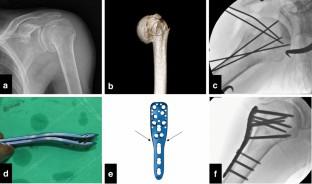Indian Journal of Orthopaedics ( IF 1 ) Pub Date : 2022-09-30 , DOI: 10.1007/s43465-022-00740-2 Sam-Guk Park 1 , Hyun-Gyu Seok 1

|
Introduction
Plate osteosynthesis is preferred for the treatment of proximal humerus fractures (PHFs). However, applying the locking plate flush against the bone may lead to varus malreduction and medial displacement of the humeral head. We hypothesized that slight valgus reduction and valgus bent locking plate fixation against potential varus deformation would yield better results than the traditional plate fixation.
Methods
We retrospectively reviewed patients with PHFs treated with locking plate fixation between March 2014 and July 2019. We evaluated changes in the neck–shaft angle (NSA) and humeral head height, as well as the development of complications postoperatively. Clinical outcomes were measured at 1-year post-surgery and at the last follow-up using the American Shoulder and Elbow Surgeons, the Disabilities of the Arm, Shoulder and Hand, and the Constant–Murley scores.
Results
A total of 58 patients with PHFs were enrolled in this study. They were divided into the valgus-aligned group (n = 28) and the anatomical group (n = 30). According to radiographic evaluation, immediate postoperative NSA was significantly greater in the valgus-aligned group. Moreover, the NSA measured at the last follow-up was significantly greater the valgus-aligned group. In contrast, the NSA became considerably more varus-aligned in the anatomical group.
Conclusion
The appropriate valgus reduction and valgus bending plate fixation could lead to better short-term results and improve the ability of proximal humerus locking plates to prevent varus collapse and fixation failure.
Level of Evidence
Level III, retrospective cohort design.
中文翻译:

锁定板治疗肱骨近端骨折:外翻复位后解剖复位与外翻弯曲锁定板固定的比较
介绍
钢板接骨术是治疗肱骨近端骨折(PHF)的首选。然而,将锁定板与骨齐平应用可能会导致内翻畸形和肱骨头内侧移位。我们假设,针对潜在内翻变形的轻微外翻减少和外翻弯曲锁定钢板固定将比传统钢板固定产生更好的结果。
方法
我们回顾性分析了 2014 年 3 月至 2019 年 7 月期间接受锁定钢板固定治疗的 PHF 患者。我们评估了颈干角 (NSA) 和肱骨头高度的变化以及术后并发症的发生情况。使用美国肩肘外科医生在术后 1 年和最后一次随访时测量临床结果、手臂、肩部和手部残疾以及 Constant-Murley 评分。
结果
共有 58 名 PHF 患者参与了这项研究。他们被分为外翻组(n = 28)和解剖组(n = 30)。根据放射学评估,外翻组术后即刻 NSA 明显更高。此外,最后一次随访时测得的 NSA 明显高于外翻组。相比之下,NSA 在解剖学组中变得更加内翻。
结论
适当的外翻复位和外翻弯曲钢板固定可以带来更好的短期效果,并提高肱骨近端锁定钢板防止内翻塌陷和固定失败的能力。
证据水平
III 级,回顾性队列设计。



























 京公网安备 11010802027423号
京公网安备 11010802027423号